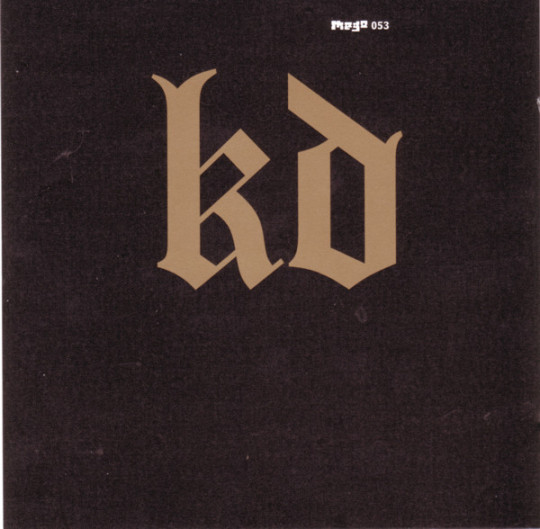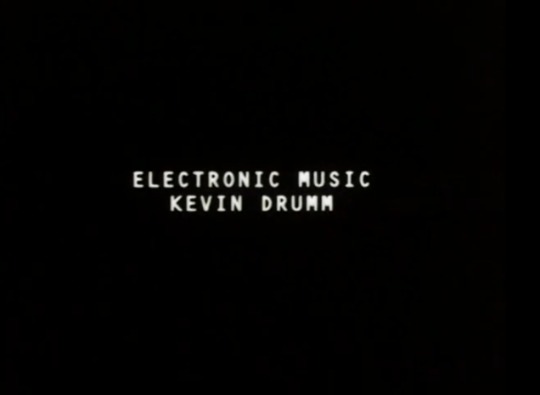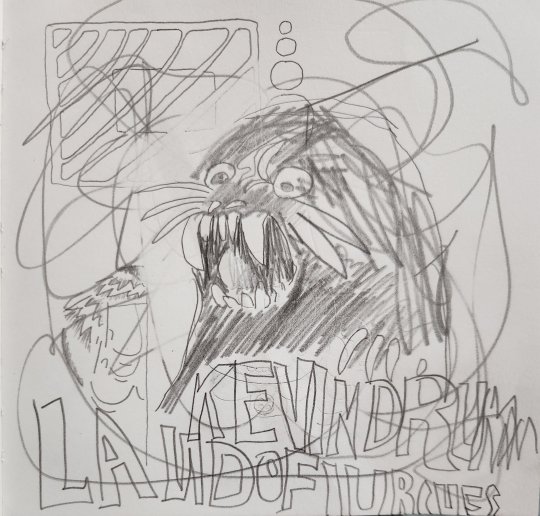#kevin drumm
Text




Kevin Drumm – Sheer Hellish Miasma
44 notes
·
View notes
Text
Kevin Drumm — OG23 (Streamline)

youtube
On OG23, Kevin Drumm simultaneously plumbs the deep seas and tumbles through outer space. Incidentally, both environments are potentially lethal; the ocean’s pressure will squish our bodies, and the vacuum of the cosmos will tear them apart. Sounds pleasant, right? Drumm thinks the concept is worth probing. With a wry smile, he’s placed a broken-down submarine right in the middle of the album’s cover. Sadly, there isn’t a damaged spaceship on the other side, but the point is obvious: these sounds evoke uncontrolled motion, existential dread, and the ironic beauty within that which threatens our survival. To borrow a concept from Harry Sword’s tome on drone music Monolithic Undertow, Drumm has created a “sonic womb.”
Drumm originally posted these multi-dimensional meanderings on his Bandcamp page in 2022. The transitory emanations are singular within his extensive catalog, and thus the sounds begged for a physical release. Enter Christoph Heemann with his Streamline label and the mastering expertise of Drumm’s longtime pal Jim O’Rourke: the ghost in the machine is now alive and it has scratched its sinister signature into vinyl.
Situating any new release within Drumm’s oeuvre is an arduous task. Between his overflowing Bandcamp catalog and his physical output, he has hundreds of releases. Drumm’s vast body of work is also a multi-dimensional continuum, morphing based on his chosen tone generating apparatus. He delivers barely perceptible hum as seriously as he does meditative drones, agitated mechanical clatter, and punishing harsh noise.
Drumm can be withholding regarding the genesis of the material he releases, and this is the case with OG23. It’s clear, however, that he’s harnessed electrons to do his bidding. The tones slide around like multi-hued oil droplets on water or condors drifting on atmospheric air currents. Sounds enter the field of perception, alter course, and then disappear like whisps of vapor. As one element vanishes, more appear. Mid and low-register swarms provide a scaffold-like hum, like a fleet of airplanes performing a flyby or the rumble of a distant factory.
OG23 resembles aleatoric or generative music in the way its tones worm around and vanish. Drumm’s established a sinister calculus and dialed in the parameters. The fractalized patterns use his framework to writhe and take on new forms. Each of the side-long pieces corrupts Drumm’s algorithm with its own unique mutation. On the A side, a flock of robotic birds explores the Starship Enterprise engine room, whereas on the flip, the passerine beings search for home within the humid air of a subterranean cavern. Drumm is the mastermind behind both scenes, reveling in the strange harmonies he’s set in motion.
Bryon Hayes
7 notes
·
View notes
Text
youtube
kevin drumm -- vertigo
2 notes
·
View notes
Text

Kevin Drumm
source: chicagoreader
📸: Susanna Bolle
#Kevin Drumm#source: chicagoreader#📸: Susanna Bolle#photography#artist photography#photo by Susanna Bolle
4 notes
·
View notes
Text
The Sonic Landscapes of Kevin Drumm:
A Journey Through Experimental Soundscapes
Kevin Drumm is an experimental musician and composer whose work spans multiple genres, including noise, drone, and improvised music. His experimental approach to sound has earned him critical acclaim and a dedicated following among fans of avant-garde music. Drumm's music is characterized by a fascination with texture, timbre, and the ways in which sound can be manipulated to create unique sonic landscapes.
Drumm's early work was primarily focused on noise music, with releases such as "Second" and "Sheer Hellish Miasma" showcasing his penchant for abrasive, distorted soundscapes. However, over time Drumm's sound evolved to incorporate elements of ambient music and drone, resulting in albums like "Imperial Horizon" and "Tannenbaum," which feature long, slowly-evolving pieces of music that build and shift over time.
One of the most interesting aspects of Drumm's work is his use of unconventional sound sources. In addition to traditional instruments like guitar and percussion, Drumm often incorporates found objects and field recordings into his compositions. For example, his album "Purge" includes sounds sourced from a 1986 IBM computer, while "Sheer Hellish Miasma" features the sound of a car engine as a prominent element of one of its tracks.
Drumm's music is often described as challenging or difficult, but it rewards careful listening and rewards those who are willing to explore its many layers. His compositions are often dense and complex, featuring multiple layers of sound that can be difficult to parse on first listen. However, repeated listens reveal new details and textures, making for a rich and rewarding listening experience.
In recent years, Drumm has continued to push the boundaries of experimental music with releases like "The Whole House," a collaboration with fellow musician Jason Lescalleet that explores the sonic possibilities of household objects. Whether he is working with noise, drone, or ambient music, Kevin Drumm is a master of experimental soundscapes, and his work continues to inspire and challenge listeners in equal measure.
2 notes
·
View notes
Text
KEVIN DRUMM / LOESSLAND - Current Issues
split cassette on JMY
2 notes
·
View notes
Text




In Order Not to Be Here (2002), Deborah Stratman
0 notes
Audio
Listen/purchase: THE EXCAVATION by kevin drumm
0 notes
Text
Kevin Drumm - Schmickedtwice (Jury Prize)
#kevin drumm#noise music#noise#subscribing to this man's bandcamp is something i will never regret#all killer no filler#harsh noise#Bandcamp
0 notes
Audio
Kevin Drumm - Sheer Hellish Miasma
10 notes
·
View notes
Text
Dust, Volume 8, Number 6

The Orange Dots
As spring makes its way into summer, the Dusted crew digs in with our monthly collection of short reviews that hits on jazz reed outings, noise-encrusted drone, fuzzed out songs, blown-out garagey rock and abstracted music for film with plenty of stops in between. Contributors this time through include Tim Clarke, Justin Cober-Lake, Bryon Hayes, Mason Jones, Jennifer Kelly, Bill Meyer, Michael Rosenstein and Jonathan Shaw. Now on to Summer!
Zoh Amba — O Life, O Light Vol. 1 (577 Records)
O Life, O Light Vol. 1 by Zoh Amba featuring William Parker and Francisco Mela
Not every 21-year-old saxophonist can say that John Zorn put out their first album and William Parker plays on their second. Zoh Amba is off to a hell of a start, but it’s fair to ask, what’s going on besides a case of heavy company? On the strength of the music on O Life, O Light Vol. 1, the tenor saxophonist from Kingsport, TN has her free jazz fundamentals in order. Her broad vibrato and importuning melodies recall Albert Ayler and she stands her ground while William Parker and Francisco Mela make it move around her. If that sounds like a statement of what she thinks is right rather than what new ideas she has conceived, well, let’s see what she comes up with when she’s 22. Time is on her side.
Bill Meyer
Andrew Anderson — Vagrancies (Elevator Bath)
Vagrancies by Andrew Anderson
Between the heat and the cost of living, Austin, TX gives a body good reasons not to leave the house. Andrew Anderson has put his time behind closed doors to good use by magnifying and warping the sounds of a piano, electronics, distant wildlife and his pal Thor Harris’ piano string harp into audio environments optimally designed for wandering. Are you walking streets after dark? Taking up residence on the dial in between a couple radio stations? Putting your ear so close to your happy cat’s belly that you are picking up transmissions of dreams about birds they wish they’d eaten? Maybe you are, or maybe Vagrancies just makes you think that’s what’s happening.
Bill Meyer
Asher & Jordan — Foliage (Crash Symbols)
Foliage by Asher & Jordan
Foliage is an enticing alloy crafted by Airick Asher Woodhead, who records as Doldrums, and Jordan Christoff, half of cosmic new age unit PJS. Each artist brings their own signature flair to the party, yet as a unit the duo produces something unique. Theirs is a visceral, noise-encrusted drone that constantly searches to reveal its ever-evolving contours. Scything sawtooth waves and short, spiky loops carve their way through layers of dreamy synth ambience. Woodhead’s chosen moniker calls to mind a certain act from the 1990s that recorded for both the Kranky and VHF labels. This nicely packaged cassette displays elements associated with both imprints: imagine Stars of the Lid collaborating with Matthew Bower, covering Tangerine Dream. Woodhead and Christoff pride themselves on live recording, with no overdubs or computers involved. Pursuits this daring can lead either to happy accidents or to a muddled miasma. With Foliage, it’s the former, likely due to this pair’s long-standing partnership in sound.
Bryon Hayes
Ballister — Chrysopoeia (Not Two)
Chrysopoeia by Ballister
Ballister redefines refinement on refinement on Chrysopoeia, the trio’s tenth recording. Recorded in concert at Alchemia, an establishment in Krakow, Poland that’s hosted the combo many times since saxophonist Dave Rempis, cellist Fred Lonberg-Holm and drummer Paal Nilssen-Love first convened in 2009, it makes a virtue of familiarity. The knowledge of one another’s moves that comes from improvising complete concerts, night after night and tour after tour, results in music that feels unerringly right at the same time that it makes the listener stop and ask — what the fuck was that? Sometimes the question is inspired by some unearthly sound, or a ratcheting of tension beyond the point where the wrench ought to shatter, or a sudden moment of restraint within the full-on barrage. Or maybe it’s asked after the CD’s 51 minutes have passed, when you’re wondering what just went down. Or maybe it’s when you take the long view and consider that these guys sound as committed and exciting as they did a decade ago. But the question is always asked appreciatively. Ballister has done it again.
Bill Meyer
Kevin Drumm — !!! (JMY)
!!! by Kevin Drumm
You might not see Kevin Drumm playing concerts, not notice labels releasing new LPs of his music, but that doesn’t mean he’s unproductive. If you head over to his Bandcamp page and subscribe, you’ll enjoy a steady flow of new music, ready for you to stream or download. “!” and “!!” were first released there in August 2020, but JMY proprietor Brent Gutzeit (also of TV Pow) has brought them into the physical world, albeit as a humble CDR. Both tracks last over twenty minutes and they offer contrasting immersive experiences. The first is a big blast of noise, which feels grating and monolithic until you give it your undivided attention. Then, it differentiates into a maelstrom of not-quite-identifiable sonic detritus, an audio equivalent to the dense mess that a planet might dissolve into after the monitoring galactic cops accidentally bump the Annihilate button while reaching for the cosmic snack box’s last donut. The second is quieter, but no less quizzical. It appears to be a mix of field recordings that have been woven together like memories in an unbounded reverie.
Bill Meyer
Alexandra Grimal — refuge (Relative Pitch Records)
refuge by Alexandra Grimal
Somehow, Swiss musician Alexandra Grimal has escaped my notice up to now. This solo soprano saxophone release, recorded in the double helix staircase in the castle of Chambord, France during a residency she spent there changes all that. Working with the natural resonance of the open, central edifice, Grimal’s eight pieces, ranging from two to 16 minutes long, utilize sonorous snaking themes that hang and twist back on themselves like the circuitous setting where they were recorded. Grimal utilizes a full tone colored by multiphonics, letting notes hang, filled out by the relatively short decay of the warm reverberations of the space. Grimal lets each piece develop slowly, never rushing notes or ideas, letting densities and volume ebb and flow. Take “château,” where sections drop to a near whisper and then ultimately build to long quavering tones that mount in surging waves. On “martinets,” short notes are placed with sharp attack against silence melding seamlessly in to “vent,” which weaves a songlike line with an abstract lyricism. That sense of songlike structure appears again with “escalier,” which builds from angular, melodic kernels that slowly accrue with a birdsong-like delicacy. A look at Grimal’s site reveals that she’s about to drop a recording of songs with electronics composed during the same residency at Chambord while working on a composition for four voices. Clearly, she’s a on a roll and worth keeping an eye on.
Michael Rosenstein
Bill Harris — Blinking Glue (Amalgam)
Blinking Glue by Bill Harris
If you attend free jazz concerts and multi-disciplinary performances in Chicago in recent times, you are likely to have shared space with Bill Harris. Sometimes he’s the guy at the drum kit, powering music made with Jake Wark, Matt Piet, Ishmael Ali, or the total improv trio of Harris, Jim Baker and Brandon Lopez (full disclosure — I wrote liner notes for that group’s forthcoming album, Dura). Other times, he’s recording the concert. On Blinking Glue, his skill sets of percussionist, sound capturer, and electronic tone manipulator converge. The 24-minute-long recording documents Harris alone, the day after Boxing Day 2021, but don’t call it a drum solo; Harris is a one-man band. The first sounds are scything feedback sweeps whose serrated edges would make many guitarists envious. But since the feedback comes not from a guitar, but from parts of Harris’ kit, it is integrated into the harsh punctuations and rushing, rhythmic forays of his drumming. If you are a fan of physical media, be aware that the compact disc, like many Amalgam releases, is a CDR; be further informed that the disc’s sleeve, which reproduces illustrations taken from a report on the condition of the Chernobyl nuclear reactor, is a thing of beauty.
Bill Meyer
Interior Geometry — Tore Through the Sky (Self-Release)
TORE THROUGH THE SKY by interior geometry
Jared Sparkes piles the fuzz onto his tuneful songs, hedging in bright, positive melodies with thickets of discordant guitar sound. Your natural inclination is to bring in the Guided by Voices comparisons, but tunes like “What Have You Done?” have more of Superchunk’s detuned vulnerability than Pollard’s teenaged kicks, and “Wet Swans Go On & On” echoes and hisses like a Pink Reason outtake or maybe a tune by the Quietus. This latest missive from Michigan’s burgeoning indie pop/punk scene bears the imprint of Fred Thomas’ influence; he produced and plays bass on two tracks. Mary Fraser of the Ypsilanti band Child Sleep sings soft, nearly twee vocals on “Tender Terrible,” musing that “you are something tender…in a terrible world.” But it’s mostly Sparkes, cranking up the noise to veil but never entirely obscure the sweetness of his songs. Buy the physical copy and you’ll get a spiral notebook full of sketches by Detroit-based artist Grace Millard, as well as photos and lyrics.
Jennifer Kelly
Masayo Koketsu — FUKIYA (Relative Pitch Records)
FUKIYA by Masayo Koketsu
Starting out with a burred surge, alto saxophonist Masayo Koketsu makes it clear that she understands the notion of tension and release. For the ensuing 46 minutes, she mines that command with an entrancing solo that draws on the vocabulary of free jazz, Japanese folk tunes, skronk overblowing and a canny balance of intensity and silence. That sense of balance defines the entire release. She embraces sections of brawny vigor, punching out squawking yelps imbued with harsh overblown multiphonics then drops to stark silence. Fifteen minutes in, she introduces a sliding theme that evokes the breathy phrasing of a shakuhachi folk theme and then decomposes it into skirling flutters which build to raw lamentations. The solo swells with a raucous astringency which carries through with chafed yawps and dark, abraded, mournful musings. But Koketsu’s underlying sense of pacing and structure hold this all together. She ties these discrete events together with resolute control and a clear sense of the trajectory of the piece, wending her way to a doleful conclusion. It is no mean feat to pull off an extended solo outing. With FUKIYA, Koketsu establishes that she is more than up to the task.
Michael Rosenstein
Bennie Maupin & Adam Rudolph — Symphonic Tone Poem for Brother Yusef (Strut)
Symphonic Tone Poem for Brother Yusef by Bennie Maupin & Adam Rudolph
Adam Rudolph played percussion alongside the great reedist Yusuf Lateef for much of his career, accompanying him in a spiritual/musical journey that touched on Eastern and African traditions as much as American jazz from 1988 until Lateef’s death in 2013. Much more than a drummer, he composed alongside Lateef on landmark albums including The World at Peace and Beyond the Sky. To celebrate Lateef’s 100th birthday, Rudolph joined with another celebrated jazz woodwindist, Bennie Maupin, to compose this tribute. Maupin is best known for his work on Miles Davis’ Bitches Brew, but like Lateef, he is a man of wide interests and skills.
Across these five movements, the two men traverse a varied, magical realist terrain, constructed from saxophone, electronics, voice and percussion. The first movement shimmers with latent energies, heated scrawls of saxophone across murmuring backgrounds of electronic tone, insistent rhythms of hand drums and tonal percussion sketching a time-path through primordial mists. The second blows a plaintive flute over humid silence, scattering xylophone notes like jewels in its wake; a steady pulse of drums, the crash of gongs, the glow of electronic keyboards, the intermittent shouts of one of the players join in an inscrutable sort of dance. Movement three wavers like a heat mirage, while number four rattles and mutters like a techno track. There is an intuitive give and take between the two players but also an ecstatic release, as mindfulness gives way to Zen-like no mind. Wonderful stuff.
Jennifer Kelly
Anthony Moore — Flying Doesn’t Help (Drag City)
Flying Doesn't Help by Anthony Moore
Having reissued 1976’s Out in 2020, Drag City continues their campaign to introduce twenty-first-century listeners to the wonders of Anthony Moore. Perhaps best known as a member of Slapp Happy and Henry Cow, Moore also released music under his own name, which has its own specific and addictive flavor. Broadly speaking, this remastered edition of 1979’s Flying Doesn’t Help belongs among the overlapping circles of a Venn diagram that includes art-rock, glam and post-punk. Though his albums flew under the radar at the time, they sit proudly alongside obvious reference points such as early Roxy Music, Eno’s Here Come the Warm Jets and Berlin-era Bowie. Opener “Judy Get Down” is an absolute cracker, crammed to the gills with sing-along hooks, while the remainder of the first side has plenty more fizzing pop gems and sneering choruses. However, Moore doesn’t let you forget his experimental credentials. “Ready Ready” opens with a glorious lattice of overlapping sheet-metal guitar waves, then its main riff is underpinned by what sounds like the pulse of a car alarm. The intimidating wall of noise that kicks off “War” goes some way towards evoking the horrors of its title. And the closing instrumental “Twilight (Uxbridge Rd)” is an uneasy send-off, pairing warbling synths with distant, eerie saxophone squeals.
Tim Clarke
Kyle Motl / Patrick Shiroishi — Apparitions (Notice)
Apparitions by Kyle Motl/Patrick Shiroishi
Who witnesses the ghostly visions referenced in this tape’s title? Might it be Patrick Shiroishi, a man of several saxophones, or double bassist Kyle Motl? Or might they be hoping to induce you, dear listener, to perceive things that type no weight on the scale? Neither player is the kind of guy who is inclined to be confined by mandates of instrumental or stylistic expectations, and both invest the music they make with a meaning beyond the undeniable impact of the raw scrapes, explosive snaps, coarse multiphonics and intricately twisted lines that they play. Since the specter that moves through walls can still stop your heart, perhaps they want to be apparitions, not see them. There is something undeniably eerie about these improvisations. Wear your garlic cloves, and keep your ears unstopped; there’s nothing going on here that you want to miss.
Bill Meyer
Nihil Nihil Nihil — Things Fall Apart As They Shall (Caligari Records)
Things Fall Apart As They Shall by NIHIL NIHIL NIHIL
That looks like a whole lot of nihilism — but what you get on Things Fall Apart As They Shall is a whole lot of death rock, heavy on the metal, partial to some post-punk. The spirit of Ian Curtis is being conjured by the unnamed vocalist (the interwebs are pretty short on info about the band), but it’s clearly schtick. Curtis came by his stilted, performative singing style honestly, as a byproduct of his anxieties and dread. Nihil Nihil Nihil do their best to summon dread and the four tunes (three originals and a cover of a Chameleons song) on this EP have a promisingly morbid sensibility. Mid-to-downtempo bummer rhythms, gits with some growl and gritty drama dominate. This reviewer responds especially well to “Further Inwards,” in which the band lets its goth thang strut. You can just about smell the mascara sizzling and it works. Just how morose, pessimistic and pissed these dudes really are remains to be seen. A full-length release would be revealing, if the world doesn’t beat them to the punch and completely fall apart. This EP isn’t quite the soundtrack for an event that doom-struck, but you can sure shake your butt to “Dance the End” while reading about the latest awfulness from Nigeria or Palestine or Ukraine. Now that’s some nihilism.
Jonathan Shaw
The Orange Dots — Nautic Girl (self-released)
Nautic Girl by The Orange Dots
This Norwegian duo present six tracks of blown-out garagey rock, with a variety of approaches making for an enjoyable ride. Tore Ljøkelsøy and Thomas Bergsten kick things off with a blast of grunge, then “Oh Lord Can You Show The Way” closes out with a gentle vocal duet. The guitar tone, buzzing and breaking apart into distortion, has an echoey, West Coast psych feel to it, while the drums fill the crevices with splashes, fills and rolls. The tick-tock drums and southern blues guitar of “Change Will Come” move from atmospheric jam into full-on heavy fuzz intensity. Amidst the distorted chaos, their intermittent dual-voiced vocals, simply chanting the title, work quite well. “Lost A Dream” alternates heavily blasted guitar and frenetic pounding drums with brief pauses for peaceful, reverbed vocals, then “Born Again” offers a break, with its quietly plucked guitar, gentle drums and airy vocals, slowly growing more tangled. After the fun instrumental jam “Duo For Mallets & Guitar,” with what seems to be xylophone and inner-space guitar noisings, the duo close out with a simple and visceral chugging rock tune. The wonderfully-named “Woke Up Dead With Nothing To Do” locomotives along nicely, with a break in the middle filled with tape delay overdrive and multi-limbed drum flailing. In its final minute the song returns to its opening chug and finishes with a strong MC5 vibe. Nicely done.
Mason Jones
R.E. Seraphin — Swingshift EP (Dandyboy/Mt. St. Mtn/Safe Suburban Homes)
"Swingshift" by R.E. Seraphin
Five originals and two covers from the Bay Area fuzz master, R.E. Seraphin thread the needle between twee pop and the melodic garage rock roar. Last time around, reviewing the Tiny Shapes disc in 2020, I likened one of his songs to “a summer radio megahit heard from several rooms away, bittersweet and slipping away even as it plays.” A year later, his tunes are similarly soft and scratchy, like a Jesus & Mary Chain song put on late at night, softly, so that you can barely hear it. So, while “Playing House” thumps and blares in an instrumental backing redolent of Exploding Hearts, its verse and chorus are murmured in your ear. Jangly “Stuck in Reno” mines the all-weather rock ’n roll topic of being out of place (in this case, in Nevada) but at a nostalgic low simmer, as if this disastrous road trip were already softened by time and memory. The two covers near the end demonstrate Seraphin’s excellent taste and bifurcated interests. “I’ll Be Around,” from the Wipers, gives him a chance to show off some lovely, driving bass and mine the power of a simple, urgent chorus. The Television Personalities “This Time There’s No Happy Ending” explores the poppier, trippier side of Seraphin’s aesthetic. If you like lo-fi pop of the Bay Area (Reds, Pinks and Purples, Umbrellas) or even New Zealand variety, check out Seraphin.
Jennifer Kelly
Paul Slavens — Alphabet Girls, Vol. II (State Fair)
youtube
Paul Slavens makes no sense. He's had some solo releases and played in some interesting Denton, TX-area indie bands. He's also been a radio host and a voice actor, though he admits to being “not too impressed” with his own vocals (maybe Fullmetal Alchemist doesn't prepare you for singing). His latest endeavor finishes a project first started over a decade ago. He now releases Alphabet Girls, Vol. II, completing a series of songs inspired by 26 abecedarian women's names. The songs provide a vehicle for the breadths of Slavens’ influences. Listeners who know him only has a member of the Travoltas or the Baptist Generals might be surprised by the jazz and stage influences.
Slavens sees himself more of a composer than a traditional songwriter and moments on the album tie in more to jazz or even cinematic scores (given a time machine, he could write for an early Bond movie). Scott Walker makes for a reasonable touchpoint, as does some of Tom Waits’ career, although Slavens’ voice is unlike either of theirs and his mania comes across more happily. “Ophelia” gives a tongue-in-cheek talk with the Hamlet character, its zaniness heightened by following the lovely “Naomi” and preceding the theatrical “Priscilla.” “Queenie” adds some bebop to the mix. The whole record precedes like this, gleefully skipping around, mixing playfulness and classiness, all developing Slavens’ strange ideas and strong compositions.
Justin Cober-Lake
Squirrel Flower — Planet EP (Polyvinyl)
Planet EP by Squirrel Flower
Squirrel Flower’s Ella Williams constructed Planet EP out of leftovers from her second, environmentally focused LP, Planet (i). Minimally produced, sparsely instrumented, these seven tracks showcase the lovely fragility of Williams’ voice, often twined around itself in translucent harmonies and agilely supported by flurries and bursts of acoustic guitar. The artist continues to make a distinctive space for herself in the crowded singer-songwriter space, breathing delicate life into knotty sentiments and leaning into the sheer beauty of her melodies. But while Planet (i) considered global, environmental catastrophe, Planet EP is far more personal, centered on the unsatisfactory dynamics of uneven love. “Open Wound” pokes at the underpinnings of a romantic relationship, the narrator seeking support and understanding, her lover unresponsive. The song builds in overlapping layers of meaning and tone, overdubbed voices swelling then fading as Williams intones “I won’t do it, I won’t do it” and a siren wails. “Your Love Is a Disaster” traverses similar emotional terrain, its plaintive request, “take me dancing,” evidently falling on unhearing ears. The Bjork cover, “Unravel,” is an unassuming triumph, Williams’ voice high and pure and echoing, making the choruses both vast and introverted. Heartbreak rarely sounds so spectrally pretty.
Jennifer Kelly
Teddy and the Rough Riders — Teddy and the Rough Riders (Appalachia Record Co.)
youtube
Teddy and the Rough Riders probably wouldn’t do so well at San Juan Hill. At least not in battle, but maybe their music would go over okay. The group doesn’t quite fit in anywhere, which means they fit in everywhere. With their self-titled debut album, the group shows its comfort blending related styles into a cohesive album. The country sound runs throughout the disc, but the band turns from 1968 San Francisco to 1972 Nashville to more modern Southern rock and country-folk with aplomb. Margo Price’s production (and a guest vocal spot) helps organize everything but never hinders the fun. Luke Schneider’s pedal steel adds plenty of flavor (even as he keeps his experimental side in check), but the songs each bring their own character. The use of the past peaks with cowboy closer “Hey, Richard,” a tribute to the mythology of Little Richard, a thought of the ghosts of both rock ‘n’ roll and country. The group might acknowledge its forebears, but it doesn't linger on these ghosts. Utilizing the best of a broadly considered country-rock aesthetic, Teddy and the Rough Riders make music more permanent than a poltergeist and more potent than pastiche, but still plenty playful.
Justin Cober-Lake
Terminal Nation / Kruelty — The Ruination of Imperialism (20 Buck Spin)
The Ruination Of Imperialism by Terminal Nation / Kruelty
With this downtuned, densely crunching and death-driven split, Terminal Nation and Kruelty seem to be militating for the accolade of heaviest record of the year. Regular listening may find you listing floor-ward, weighed down by the riffs’ irresistible gravitational pull. Terminal Nation’s side of the split is the real monster, a Boss pedal manifesto of lefty vituperation and revolutionary zeal. You usually encounter that sort of ethos on the punkier end of heavy music’s continuum, but Terminal Nation is pissed and convincing about it. Two-thirds of the way through “Curators of Brutality,” vocalist Stan Liszewski repeatedly hollers, “We have the numbers!” That’s direct action he’s demanding, folks. On the flip, Japanese hardcore freaks Kruelty do their characteristic thing: long, piledriving, midtempo beatdowns, with death metal-inspired growls aplenty. Both of their tracks are quite good. But it’s hard to match Terminal Nation’s energy and passionate political fury, which is serious stuff to shout about in Little Rock, Arkansas. Somehow, Liszewski’s vocals ride the top of Dalton Rail’s and Tommy Robinson’s amp abuse. He snarls, “There must be retribution / Before redistribution.” Right on, brother.
Jonathan Shaw
Rafael Toral — Music For Film (Noise Precision)
Music for Film by Rafael Toral
There’s no way that Rafael Toral, a rigorous student as well as a skilled shaper of evocative sound, is unaware of Brian Eno’s Music For Films. So, what gives with the absent S? The meaning turns out to be literal; this DL-only recording, which is available from Toral’s Bandcamp page, comprises music he recorded for a short film, Pedro Cabaleira’s By Flávio. If you caught it at the 72nd Berlin International Film Festival, you could let me know how the music worked in that context. But it stands quite well on its own; so well that one wonders why it’s only being released in such an ephemeral format. This is Toral’s first recording in a couple decades to put the guitar first, and if you have a hankering for his 1990s work using that instrument, and especially Sound Mind Sound Body, then it’s time for you to pop the cork on that special bottle you’ve been saving. The long, unfurling tones are very much in the spirit of that recording, although years of experience in fundamentally dissimilar musical contexts ensure that this is not simply a matter of picking up where he left off. These days, Toral’s music is, like a lot of us, a bit roughed up, with gritty, ground-down textures pushing through the fluorescent glow. Rumor has it that there’s a new, proper album on the horizon; if this is an advance trailer, then the finished feature might be quite something.
Bill Meyer
#dusted magazine#dust#zoh amba#andrew anderson#asher & jordan#ballister#kevin drumm#alexandra grimal#bill harris#interior geometry#masayo koketsu#bennie maupin#adam rudolph#anthony moore#kyle motl#patrick shiroishi#nihil nihil nihil#the orange dots#r.e. seraphin#paul slavens#squirrel flower#teddy and the rough riders#terminal nation#kruelty#rafael toral#tim clarke#justin cober-lake#bryon hayes#mason jones#jennifer kelly
3 notes
·
View notes
Text


Builder's Rite | Kevin Drumm - Land of Lurches
7 notes
·
View notes
Text
Let me introduce you guys here on Tumblr, my new character made in 3 days ago at DeviantArt and then every discord server I still have including mine. This is Kevin Seok and he's American-Korean who plays drumms and he's younger than my characters.
Main Outfit:

Alternative:

#blue#dark blue#long haired male#male#asian#asian male#korean#american#asian american#Kevin Seok#Kevin#vincentbit#black hair#grunge#punk#grungy clothes#grungy fashion#grungy style
3 notes
·
View notes